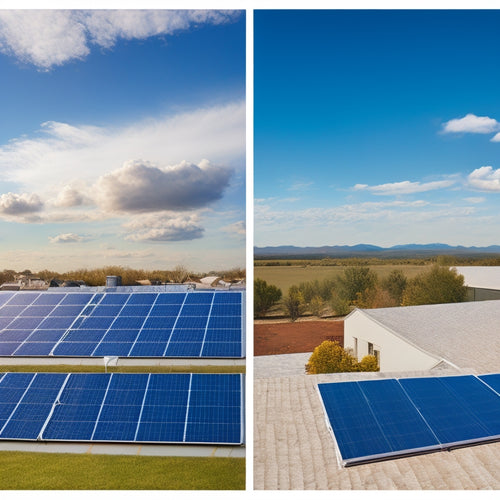
What Do the Top 5 Solar PV System Costs Include
Share
When investing in a solar PV system, you can expect the top 5 costs to include module and inverter expenses, influenced by factors like efficiency and technology type, as well as installation labor expenses, which are impacted by labor training, site preparation, and system complexity. Additionally, you'll need to evaluate mounting and tracking system costs, which vary depending on the type and roof compatibility. Electrical and balance components, such as inverters and wiring, also make up a significant portion of the expenses. Finally, permitting and inspection fees round out the top 5 costs, adding a few percentage points to your overall total.
Key Takeaways
- Module and inverter costs are influenced by efficiency, technology type, and monitoring capabilities, impacting overall system cost and performance.
- Installation labor expenses depend on training, certification, site preparation, system design, and local labor rates, affecting overall installation costs.
- Mounting and tracking systems, including fixed, single-axis, and dual-axis options, add costs ranging from $0.15 to $1.00 per watt, depending on roof type and local codes.
- Electrical and balance components, such as inverters, disconnects, wiring, and monitoring systems, ensure safe energy transmission and add to overall system costs.
- Permitting and inspection fees, which can add 2-5% to the total system cost, include review and approval processes, inspection requirements, and multiple visit fees.
Module and Inverter Costs
When it comes to solar PV system costs, the module and inverter costs are two of the most significant components. You'll find that these two components make up a substantial portion of your overall system expenditure.
The module costs are largely influenced by the module efficiency, which refers to the percentage of sunlight converted into electrical energy. High-efficiency modules may come at a higher cost, but they can provide more power per unit area, ultimately reducing the overall system size and installation costs.
Inverter technology also plays an essential role in determining the system's overall cost. You'll need to take into account the type of inverter technology, such as string inverters, microinverters, or power optimizers, each with its own set of advantages and disadvantages.
The inverter's efficiency, reliability, and monitoring capabilities will all impact the overall system cost. When selecting modules and inverters, you'll need to balance their costs with their performance and reliability to guarantee an ideal system design that meets your power requirements.
Installation Labor Expenses
With the module and inverter costs factored into your overall system expenditure, it's crucial to take into account the installation labor expenses that come into play.
These expenses can vary depending on several factors, including the complexity of the installation, local labor rates, and the installer's level of proficiency.
Here are some key aspects of installation labor expenses to take into account:
-
Labor training and certification: The installer's level of training and certification can impact the installation efficiency and overall cost.
-
Site preparation and assessment: The time and effort required to prepare the site, assess the roof's condition, and guarantee a safe working environment can add to the labor expenses.
-
System design and configuration: The complexity of the system design and configuration can require more labor hours, increasing the overall cost.
- Permitting and inspection: Obtaining necessary permits and undergoing inspections can also require additional labor hours and expenses.
Mounting and Tracking Systems
Now that you've considered the installation labor expenses, you'll need to factor in the costs associated with mounting and tracking systems. These components are essential for ensuring your solar PV system operates efficiently and maximizes energy production.
Mounting techniques vary, and the choice of system will impact your overall costs. Tracking technology, on the other hand, enables your solar panels to adjust to the sun's movement, optimizing energy output.
| Mounting and Tracking Systems | Cost Range |
| Fixed Mounting Systems | $0.15 - $0.30 per watt |
| Tracking Mounting Systems | $0.25 - $0.50 per watt |
| Single-Axis Tracking Systems | $0.30 - $0.60 per watt |
| Dual-Axis Tracking Systems | $0.50 - $1.00 per watt |
When selecting a mounting and tracking system, consider factors such as roof type, local building codes, and the desired level of energy production. By understanding the costs associated with these components, you can make informed decisions about your solar PV system's design and installation.
Electrical and Balance Components
Having optimized your solar PV system's energy production with mounting and tracking systems, you'll need to balance and regulate the electrical flow with electrical and balance components.
These components guarantee the safe and efficient transmission of energy from your solar panels to your inverter, and ultimately, to your electrical grid.
To achieve this, you'll need to take into account the following key electrical and balance components:
- Inverters: Convert DC power from your solar panels to AC power for your electrical grid.
- Disconnects: Allow for safe and easy maintenance and repair of your system.
- Wiring and Connectors: Facilitate the flow of electrical current between components, with careful consideration of wiring considerations and connection types.
- Monitoring Systems: Track your system's performance and identify potential issues before they become major problems.
Permitting and Inspection Fees
Beyond the technical components of your solar PV system, you'll need to maneuver the bureaucratic obstacles of permitting and inspection fees. These costs can vary depending on your location, system size, and local regulations.
The permitting process typically involves submitting your system design and plans to your local government for approval, which can take several weeks to several months. You'll need to pay fees for this review process, which can range from a few hundred to several thousand dollars.
In addition to permitting fees, you'll also need to cover inspection requirements. Once your system is installed, a local building inspector will need to verify that it meets safety and electrical codes.
This inspection may require multiple visits, and you'll need to pay for each inspection. Inspection fees can add up quickly, especially if corrections are needed.
On average, permitting and inspection fees can add 2-5% to your total system cost. Be sure to factor these costs into your overall budget to avoid surprises down the line.
Frequently Asked Questions
How Long Does It Take to Install a Solar PV System?
You'll typically spend 3-5 days overseeing the installation process, but it'll take the pros around 1-3 days to complete, depending on your system's complexity and the installation timeline, which can vary from a few weeks to a few months.
Can I Install a Solar PV System Myself?
You can attempt a DIY installation, but be aware of safety concerns, such as electrical shock and roof damage, and make certain you have the necessary tools and permits, as the permitting process can be complex and time-consuming.
What Is the Average Lifespan of a Solar Panel?
You'll get 25-30 years of reliable energy from your solar panel, with efficiency degrading 0.5-1% annually; regular maintenance, like cleaning, guarantees peak performance, and you can expect 80-90% of initial capacity after two decades of operation.
Do Solar Panels Work During Power Outages?
When the lights go dark, you're left wondering: do solar panels work during power outages? Unfortunately, traditional grid-tied systems won't function, but you can opt for battery-backed systems or generators as power outage solutions, ensuring your solar panel functionality shines on.
Can I Finance My Solar PV System Purchase?
You can finance your solar PV system purchase through various financing options, including solar loans, which offer competitive rates and flexible repayment terms, allowing you to go solar without upfront costs.
Related Posts
-

Why You Need a Phone Mount for Navigation
When you're on the road, a reliable phone mount is not just a convenience, it's a safety necessity that helps you mai...
-

5 Ways Bike Sharing Boosts Urban Sustainability
As you explore bike-sharing options, you'll discover five ways it boosts urban sustainability. By reducing congestion...
-

Tracking Solar Panels Vs Fixed Panels Cost Savings
When considering solar panel options, you'll want to weigh the cost savings of tracking solar panels versus fixed pan...


